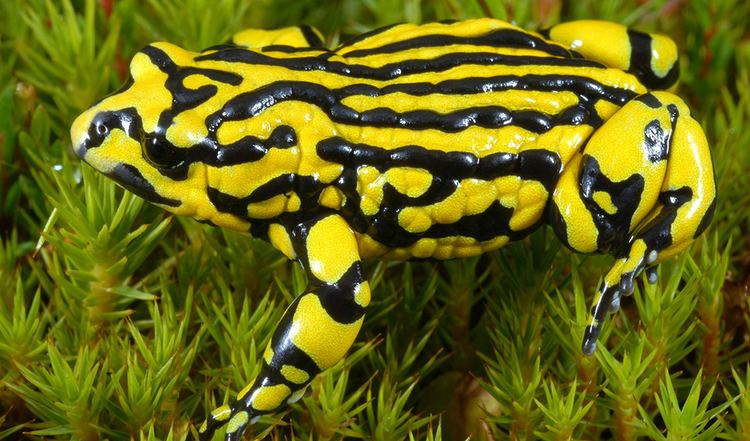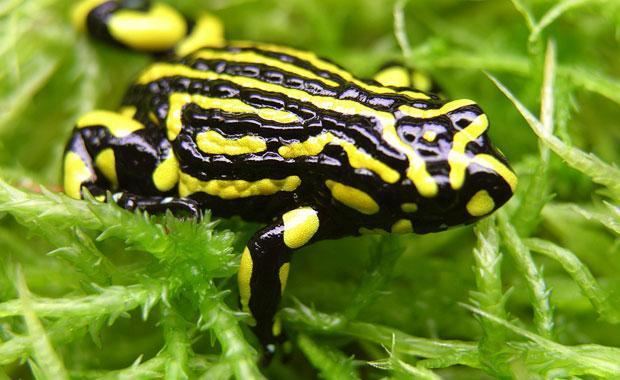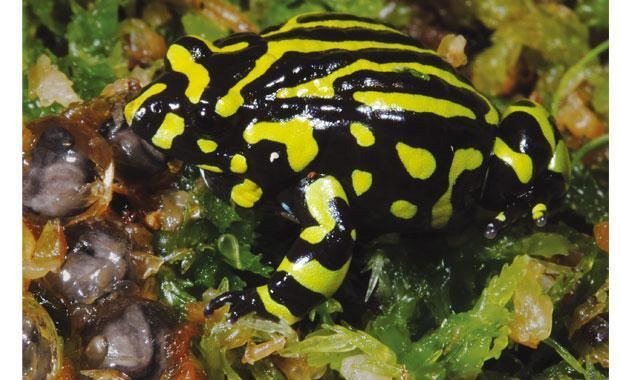 | ||
Representative species Corroboree frog, northern corroboree frog | ||
Saving the corroboree frog
The corroboree frogs are two species of small, poisonous ground dwelling frogs, native to Southern Tablelands of Australia. The two species are the southern corroboree frog (Pseudophryne corroboree) and the northern corroboree frog (Pseudophryne pengilleyi). They are unique among frogs in that they produce their own poison rather than obtain it from their food source as is the case in every other poisonous frog species.
Contents
- Saving the corroboree frog
- Distribution
- Description
- Reproduction
- Diet
- Toxicity
- Behaviour
- Conservation status
- Current status
- Cause for decline
- Conservation efforts
- References

Distribution

Corroboree frogs have different patterns. The corroboree frog is found only in 400 km² patches in the sub-alpine regions of southern New South Wales and Victoria, Australia.
Description
The northern form deviates slightly in having narrow yellow to greenish stripes and is slightly smaller.
Reproduction

Sexual maturity of P. corroboree is reached at four years of age, with one year as an embryo/tadpole and two years as a juvenile/subadult. Adults primarily have only one breeding season. Breeding occurs around December terrestrially near shallow pools, fens, seepages, wet grassland or wet heaths, where the males build chamber nests within the grasses and moss. Males compete for females via song. Each male will attract up to ten females to his burrow sequentially and may dig a new burrow if his first is filled with eggs. The female lays up to 38 eggs and the male grasps her and deposits sperm directly onto the eggs. Tadpoles develop but remain within the protective egg coat until hatching occurs when high ground-water levels after rain cause the nest to become flooded at 4 to 6 months. Tadpole development takes six to eight months. Metamorphosis occurs between December and February (Osborne and Norman 1991). P. pengilleyi prefers to breed in sphagnum bogs and wet heath in sub-alpine areas and dense patches of herbs in openings or seepages amongst fallen tussocks at lower elevation (bog pools at high altitudes above 1300 m and in shallow seepage pools in gullies at lower altitudes of 1000–1400 m). Other reproductive details are as for P. corroboree. Both species are restricted to mountain and sub-alpine woodlands, heathlands and grasslands.
Non-breeding habitat for both species occurs in forest, woodland and heath adjacent to breeding sites.
Diet

The typical diet of a mature corroboree frog includes; beetles, mites, ants and insect larvae. However, as tadpoles they also tend to eat algae and other small pieces of organic material found in their pools. (Alisha)
Toxicity

Corroboree frogs are the first vertebrates discovered that are able to produce their own poisonous alkaloids, as opposed to obtaining it via diet as many other frogs do. The alkaloid is secreted from the skin as a defence against predation, and potentially against skin infections by microbes. It has been described as potentially lethal to mammals if ingested. The unique alkaloid produced has been named pseudo-phrynamine (Daly et al. 2002).
Behaviour

Corroborree frogs are quite unusual in their nature. Not only do they not start breeding until four years of age, they also hibernate during winter under whatever shelter they can find. This may be snow gum trees, or bits of bark or fallen leaves. Males stay with the egg nests and may breed with many females over the course of one season.
Conservation status
The southern corroboree is recognised as being critically endangered with fewer than 200 individuals left in the wild in recent years. The northern species is listed as endangered.
Current status
The southern corroboree frog was considered relatively numerous within its very small distribution in the 1970s, as of June 2004 it had an estimated adult population of 64. This species has suffered declines of up to 80% over the past 10 years. It is found only within a fragmented region of less than 10 km² within Mount Kosciuszko National Park in the Snowy Mountains in New South Wales. It is only found at 1300 m above sea level (Osborne 1989). It is currently listed as critically endangered and is considered to be one of, if not, Australia's most endangered species.
The northern corroboree frog has not suffered as badly as the southern. It is more widely distributed across about 550 km² of the Brindabella and Fiery Ranges in Namadgi National Park, Australian Capital Territory, and Kosciuszko National Park and Buccleuch State Forest in New South Wales. It is found above about 1000m and is found to have higher population numbers at lower elevations. It has recently been downgraded from critical to endangered by the IUC finding.
Cause for decline
The near-loss of these frogs has been attributed to a variety of causes, such as habitat destruction from recreational 4WD use; development of ski resorts; feral animals; degradation of the frogs' habitat; the extended drought cycle affecting much of southeastern Australia at present; and increased UV radiation flowing from ozone layer depletion. The drought affects these frogs by drying out their breeding sites so that the breeding cycle, which is triggered by seasonal changes and may require moistening of the bogs in autumn and spring to bring on specific developmental events, is delayed. This may mean that tadpoles have not metamorphosed by late summer when their bogs dry out, and so perish. The bogs themselves are apparently drier than usual. Severe bushfires in the Victorian and NSW high country in January 2003 destroyed much of the frogs' remaining habitat, especially the breeding sites and the leaf litter that insulates overwintering adults. The fire affected almost all southern corroboree frog habitat, however recent surveys have shown that the fire resulted in a lower than expected decline in population.
As with many other Australian frogs, the predominant reason for the corroboree frogs' decline is thought to be infection with the chytrid fungus. This fungus is believed to have been accidentally introduced to Australia in the 1970s and destroys the frogs' skin, usually fatally. Corroboree frogs' eggs appear to be immune. Frog populations may eventually be able to acquire immunity, as wild relatively healthy adults have been found with the fungus on their skin.
Conservation efforts
The Amphibian Research Centre had already begun a rescue programme under which eggs were collected and raised to late tadpole stage before return as close as possible to their collection site. Research is now underway into captive breeding and on which lifecycle stage - eggs, tadpoles or adults - promises the best chance of survival following return to the wild. The national parks authorities in the Australian Capital Territory, New South Wales and Victoria have developed conservation programmes, including a captive husbandry programme at Tidbinbilla, ACT, Taronga Zoo in Sydney, as well as Zoo's Victoria at Healesville Sanctuary.
